|
|
Published July 17th, 2024
|
Digging Deep with Goddess Gardener, Cynthia Brian
|
| Coming in HOT! |
| By Cynthia Brian |
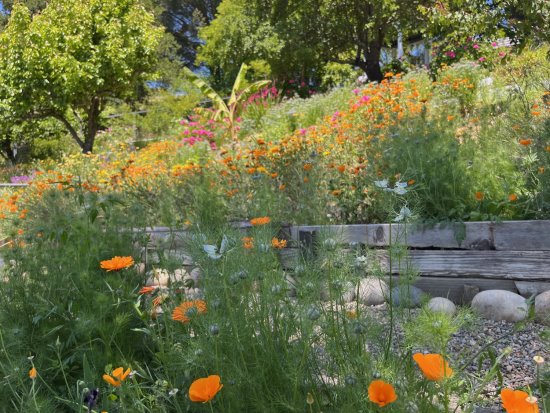 |
| The hillside wildflowers were gorgeous and abundant in June. Photos Cynthia Brian |
May the sun bring you new energy by day. May the moon softly restore you by night." Apache Blessing
 Baby, it's hot outside! Cuts and bruises from gardening in my preferred wardrobe of my bathing suit are a small price to pay to remain cooler. Our water bills are bound to be bigger this next cycle because of the recent heat wave that sent most of us craving the cooling restoration of the moon. We have buckets in the showers and sinks to collect every extra drop of H2O. We save all gray water for our plants.
Baby, it's hot outside! Cuts and bruises from gardening in my preferred wardrobe of my bathing suit are a small price to pay to remain cooler. Our water bills are bound to be bigger this next cycle because of the recent heat wave that sent most of us craving the cooling restoration of the moon. We have buckets in the showers and sinks to collect every extra drop of H2O. We save all gray water for our plants.
 Last month I showcased my spectacular hillside wildflower garden after I had completed the hand-weeding. With the 100-degree-plus temperatures that lasted over ten days, that beauty is gone, replaced by dried plants that will be cut before this article is published. (See the before and after photos)
Last month I showcased my spectacular hillside wildflower garden after I had completed the hand-weeding. With the 100-degree-plus temperatures that lasted over ten days, that beauty is gone, replaced by dried plants that will be cut before this article is published. (See the before and after photos)
 Not many blooms can withstand this heat. Fortunately, my trusty and drought-friendly natives, roses, clematis, agapanthus, pink bower vine, seafoam statice, lavender, potato vine, oleander, hollyhocks, and acanthus brighten the landscape with their flowers. The sea of bumble bee-loving blue nigella blossoms that last month blanketed the orchard has metamorphosed into seedpods. I am collecting them to give to attendees of the forthcoming September 28th Pear and Wine Festival who will visit our Be the Star You Are!r booth where our volunteers will be celebrating our 25th anniversary with the public. (For info, visit
https://www.bethestaryouare.org/events-2)
Not many blooms can withstand this heat. Fortunately, my trusty and drought-friendly natives, roses, clematis, agapanthus, pink bower vine, seafoam statice, lavender, potato vine, oleander, hollyhocks, and acanthus brighten the landscape with their flowers. The sea of bumble bee-loving blue nigella blossoms that last month blanketed the orchard has metamorphosed into seedpods. I am collecting them to give to attendees of the forthcoming September 28th Pear and Wine Festival who will visit our Be the Star You Are!r booth where our volunteers will be celebrating our 25th anniversary with the public. (For info, visit
https://www.bethestaryouare.org/events-2)
 Although my family were "dry farmers" meaning that we didn't irrigate the orchard or vines, allowing the winter rains to do their job, when heat waves arrived, we had our orders. Our dad had purchased a 1940s fire truck with a huge water tank and retrofitted it as our irrigation truck. Beginning when I was age 8, my job was to slowly drive the fire truck through the narrow rows, moving from vine to vine and tree to tree while my younger sister opened the spigots. When the tanks were empty, I drove to the well to refill. In this way, we protected our harvest when the thermometer skyrocketed into triple digits.
Although my family were "dry farmers" meaning that we didn't irrigate the orchard or vines, allowing the winter rains to do their job, when heat waves arrived, we had our orders. Our dad had purchased a 1940s fire truck with a huge water tank and retrofitted it as our irrigation truck. Beginning when I was age 8, my job was to slowly drive the fire truck through the narrow rows, moving from vine to vine and tree to tree while my younger sister opened the spigots. When the tanks were empty, I drove to the well to refill. In this way, we protected our harvest when the thermometer skyrocketed into triple digits.
 We don't have vintage fire trucks with water tanks to irrigate our gardens. How can we protect our precious gardens during extremely scorching weeks? By planting your garden with heat-tolerant and drought-tolerant varieties, your chances of enjoying a beautiful landscape throughout the summer increase. In addition to succulents, the plants blooming in my landscape fit that description. However, this is NOT the time to plant new specimens, unless you only need a few color spots of annuals. Whatever plants you purchase, make sure to watch and water diligently. Wait until the cooler days in the fall to go on a shopping spree. In the meantime, watch for signs of heat-related stress such as wilting, leaves curling, yellowing, and browning. Here are actions you can immediately employ this summer that will help keep your garden alive.
We don't have vintage fire trucks with water tanks to irrigate our gardens. How can we protect our precious gardens during extremely scorching weeks? By planting your garden with heat-tolerant and drought-tolerant varieties, your chances of enjoying a beautiful landscape throughout the summer increase. In addition to succulents, the plants blooming in my landscape fit that description. However, this is NOT the time to plant new specimens, unless you only need a few color spots of annuals. Whatever plants you purchase, make sure to watch and water diligently. Wait until the cooler days in the fall to go on a shopping spree. In the meantime, watch for signs of heat-related stress such as wilting, leaves curling, yellowing, and browning. Here are actions you can immediately employ this summer that will help keep your garden alive.
 WATER, WATER, WATER: Check soil moisture regularly. Stick a pencil or chopstick in the soil. If it is dry when removed, your plants are thirsty. Early morning or later in the evening are the best times to water. Water deeply and longer than normal. Make sure the moisture is penetrating and not running off. My preference for irrigation is late evening because the plants have hours to rehydrate. Soaker hoses and drip irrigation minimize evaporation while delivering water directly to the roots.
WATER, WATER, WATER: Check soil moisture regularly. Stick a pencil or chopstick in the soil. If it is dry when removed, your plants are thirsty. Early morning or later in the evening are the best times to water. Water deeply and longer than normal. Make sure the moisture is penetrating and not running off. My preference for irrigation is late evening because the plants have hours to rehydrate. Soaker hoses and drip irrigation minimize evaporation while delivering water directly to the roots.
 MISTING: When it is super-hot, plants, like people, enjoy a light misting. This helps cool the plant tissue. For indoor plants, place a tray of water under the container to increase the humidity,
MISTING: When it is super-hot, plants, like people, enjoy a light misting. This helps cool the plant tissue. For indoor plants, place a tray of water under the container to increase the humidity,
 SHADE, SHADE, SHADE: Use umbrellas, shade cloth, or garden fabric to cover your most sensitive plants. Build temporary tents with burlap or even bedsheets. I prefer umbrellas over my very sensitive gardenias, which can be quickly removed with temperature adjustments..
SHADE, SHADE, SHADE: Use umbrellas, shade cloth, or garden fabric to cover your most sensitive plants. Build temporary tents with burlap or even bedsheets. I prefer umbrellas over my very sensitive gardenias, which can be quickly removed with temperature adjustments..
 MOVE PATIO POTS: Move container gardens to shaded areas. Be cognizant of water needs. Deep soak most containers daily because they dry out quickly.
MOVE PATIO POTS: Move container gardens to shaded areas. Be cognizant of water needs. Deep soak most containers daily because they dry out quickly.
 WEED, WEED, WEED: Weeds compete with plants for moisture and nutrients. Eliminate weeds as necessary.
WEED, WEED, WEED: Weeds compete with plants for moisture and nutrients. Eliminate weeds as necessary.
 MULCH, MULCH, MULCH: Organic matter will increase the holding capacity of your soil. Water regularly. Mulch retains moisture in the soil longer.
MULCH, MULCH, MULCH: Organic matter will increase the holding capacity of your soil. Water regularly. Mulch retains moisture in the soil longer.
 REFRAIN FROM FERTILIZING AND PRUNING: Avoid heavy feeding or pruning during heat waves as these actions stress your plants. If a fertilizer is needed, choose an organic, balanced slow-release option.
REFRAIN FROM FERTILIZING AND PRUNING: Avoid heavy feeding or pruning during heat waves as these actions stress your plants. If a fertilizer is needed, choose an organic, balanced slow-release option.
 Make sure to refill fountains and birdbaths to provide drinks for the wildlife. The birds, hummingbirds, bees, butterflies, bats, and other pollinators are grateful visitors. Foxes, skunks, raccoons, rabbits, reptiles, and squirrels have also enjoyed a cool cocktail in my water features! When we work in the garden, we can easily get dehydrated. Drink plenty of water, wear sunglasses, sunscreen, and a big hat. Jump in your swimming pool or spray yourself with a hose when you feel heated, whether you are wearing your bathing suit or your overalls! Softly restore your spirit with the moon, and rejuvenate your body under the stars with the cooler nights. This summer is coming in hot!
Make sure to refill fountains and birdbaths to provide drinks for the wildlife. The birds, hummingbirds, bees, butterflies, bats, and other pollinators are grateful visitors. Foxes, skunks, raccoons, rabbits, reptiles, and squirrels have also enjoyed a cool cocktail in my water features! When we work in the garden, we can easily get dehydrated. Drink plenty of water, wear sunglasses, sunscreen, and a big hat. Jump in your swimming pool or spray yourself with a hose when you feel heated, whether you are wearing your bathing suit or your overalls! Softly restore your spirit with the moon, and rejuvenate your body under the stars with the cooler nights. This summer is coming in hot!
 - The Contra Costa Library has numerous free in-person and online events. I'm enrolled in Amazing Hummingbirds on July 22. The library hosts events about wildlife and other nature-related topics with Outdoor Explorers. Check out www.ccclib.org for upcoming classes and experiences for all ages.
- The Contra Costa Library has numerous free in-person and online events. I'm enrolled in Amazing Hummingbirds on July 22. The library hosts events about wildlife and other nature-related topics with Outdoor Explorers. Check out www.ccclib.org for upcoming classes and experiences for all ages.
 - Native Plant Resource Teams also provides free Zoom classes in support of native gardens. On July 23, you can learn to create a bird-friendly garden. www.nativeplantresourceteams.net
- Native Plant Resource Teams also provides free Zoom classes in support of native gardens. On July 23, you can learn to create a bird-friendly garden. www.nativeplantresourceteams.net
 Happy Gardening. Happy Growing. Stay cool!
Happy Gardening. Happy Growing. Stay cool! |
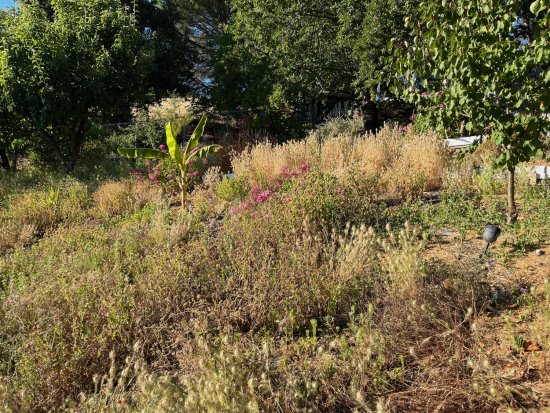 |
| The hillside wildflowers died in the heat. Photos Cynthia Brian |
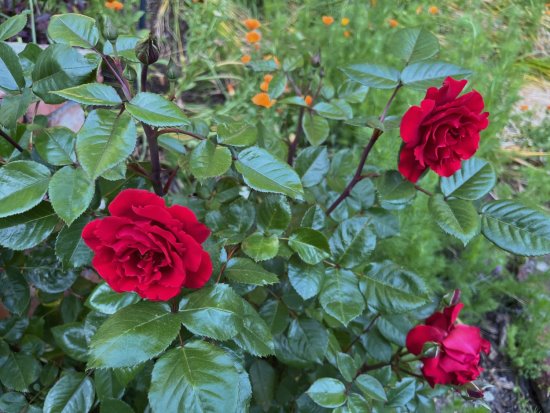 |
| Wichura red roses thrive in summer. Photos Cynthia Brian |
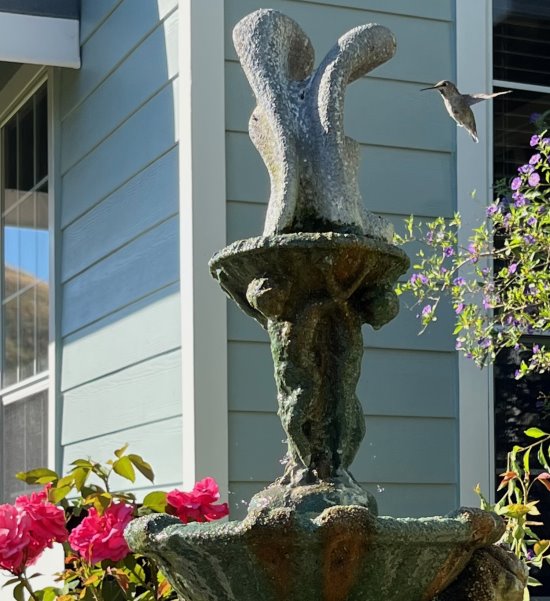 |
| Anna's hummingbird stops by the fountain to refresh. Photos Cynthia Brian |
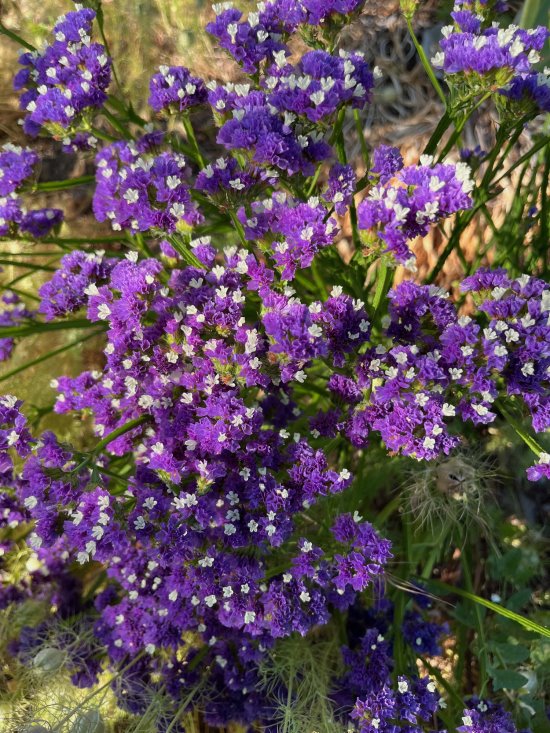 |
| Seafoam statice is drought-resistant and maintains its brilliant purple/blue hue. Photos Cynthia Brian |
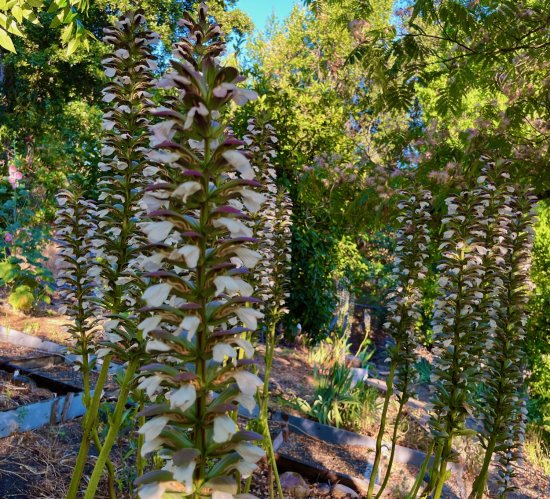 |
| Bears Breech, AKA acanthus has spectacular cream spears in summer
with glossy green foliage in spring. |
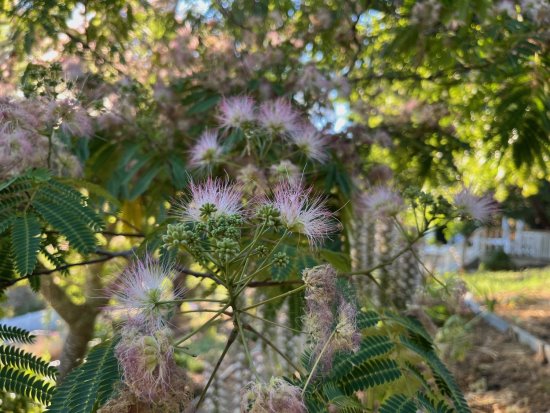 |
| Silk tree with its pink puff-ball flowers is elegant and delicate,
yet hardy. |
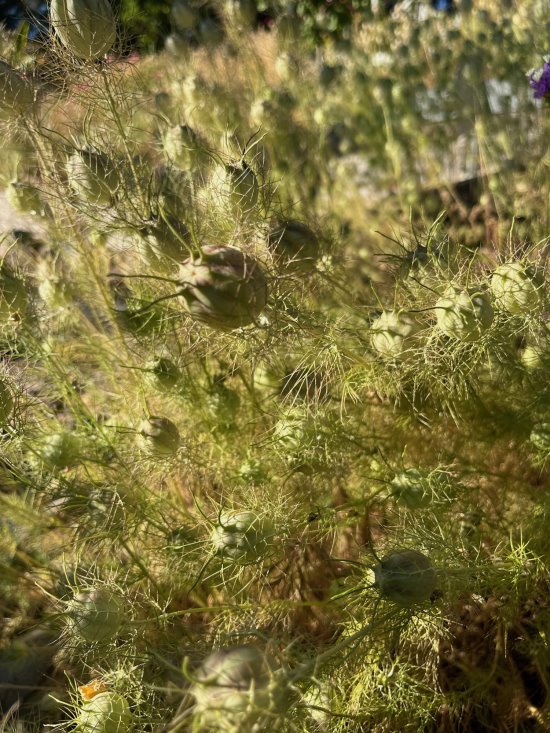 |
| The seedpods from the nigella flower are used in dried
arrangements. |
 |
| Lavandula latifolia, Portuguese lavender, flourishes in the heat. |
 |
Cynthia Brian stays cool in the pool.
For more gardening advice for all seasons, check out Growing with the Goddess Gardener at
https://www.CynthiaBrian.com/books. Raised in the vineyards of Napa County, Cynthia Brian is a New York Times best-selling author, actor, radio personality, speaker, media and writing coach as well as the Founder and Executive Director of Be the Star You Are!r 501 c3 which was just honored as the 2024 Nonprofit of the Year by the Moraga Chamber of Commerce. Tune into Cynthia's StarStyler Radio Broadcast at
www.StarStyleRadio.com. Her newest children's picture book, Books in the Barnyard: Oh Deer!, from the series, Stella Bella's Barnyard Adventures is available at
https://www.CynthiaBrian.com/online-store. Hire Cynthia for writing projects, garden consults, and inspirational lectures.
Cynthia@GoddessGardener.com
https://www.CynthiaBrian.com |
|
|
|













